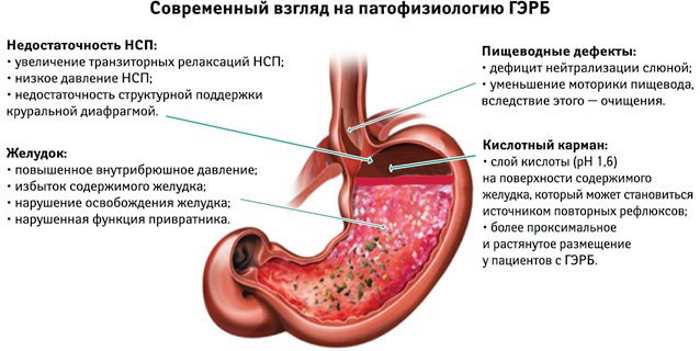Cirrhosis of the liver - a progressive chronic disease characterized by degenerative changes in the structure of the organ. Its danger is that at the initial stage, the pathological process has common symptoms, which few people pay attention to.
The disease in men is diagnosed 3 times more often than in women. Often, cirrhosis appears with excessive alcohol consumption, but this is not the only provoking factor in its development.
Record content:
- 1 The reasons for the development of the disease
- 2 Risk factors
- 3 Classification of the disease
- 4 Symptoms of pathology in women, men
-
5 Diagnostics
- 5.1 Laboratory research
- 5.2 Hardware diagnostics
-
6 Treatment of the disease
- 6.1 Medicines
- 6.2 Folk remedies
- 6.3 Surgical intervention
- 6.4 Diet therapy
- 7 Prognosis and complications
- 8 Video about liver cirrhosis
The reasons for the development of the disease
As a result of cirrhosis, hepatocytes gradually die and are replaced by connective fibers. With the development of the pathological process, the remaining healthy cells of the organ begin to rapidly divide. This leads to disruption of the liver, because fibrous tissue is not able to perform the function of hepatocytes.
There are 2 main root causes of the development of this pathological process: alcoholism and viral hepatitis (mainly B, C). Against the background of these provoking factors, about 80% of all cases are diagnosed.
Other possible reasons:
- Automic hepatitis. The disease occurs as a result of a failure of the immune system, as a result of which the body begins to perceive liver cells as foreign, and gradually destroys them.

- Long-term cholestasis. The disease is characterized by blockage of the intra- and extrahepatic biliary tract. The pathological process develops within 3-18 months from the moment of obstruction.
- Metabolic disorders associated with genetic defects (Westphal-Wilson disease, alpha-1-antitrypsin congenital insufficiency).
- Prolonged venous hyperemia in the organ (Budd-Chiari syndrome, sinusoidal liver obstruction syndrome, heart failure, constrictive pericarditis).
- Intoxication with drugs, harmful substances.
- Chronic deficiency of proteins, vitamins in the diet.
Sometimes it is not possible to establish the root cause of the development of cirrhosis. Also, in 50% of patients, liver dysfunction occurs in the presence of several provoking factors.
Risk factors
Liver cirrhosis develops in people over 40-45 years old. More than 70-75% of all cases are diagnosed in men.
Specialists identify certain risk factors, the presence of which increases the likelihood of cirrhosis:
- Diabetes mellitus type 2. Elevated insulin levels cause an intracellular accumulation of lipids in the liver and in the body as a whole.
- Obesity. Disruption of metabolic processes contributes to degenerative changes in the liver.
-
A sharp decrease in body weight. The active breakdown of fat stores caused by the action of nicotine, caffeine and hormones promotes the release of fatty acids, which are subsequently taken up by the liver.
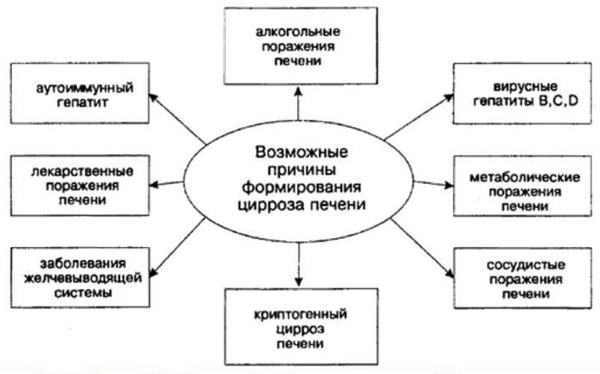
- Excessive consumption of glucose, fructose. These carbohydrates are converted most rapidly into fatty acids, which are stored in the liver.
Classification of the disease
Cirrhosis of the liver (symptoms in women and men differ in different types of the disease) is chronic.
Against this background, experts distinguish the following types of disease:
- Viral. It occurs with hepatitis B, C, D. The pathogen enters the body sexually, in utero, through the blood.
- Toxic. The trigger mechanism can be the systematic use of harmful substances and minor poisoning. A feature of this form of the disease is impaired consciousness, mental disorder.
- Congenital. Represents a set of hereditary factors.
- Stagnant. Cirrhosis occurs when there is insufficient blood circulation.
- Exchange-alimentary. Appears in obesity and advanced diabetes mellitus.
- Cryptogenic. This type includes cirrhosis, the root cause of which remains unclear.
- Biliary. With this type, the pathological process extends to the bile ducts. Biliary cirrhosis is primary and secondary. The first form is characterized by gradual damage to the ducts. It is diagnosed more often in women and is often asymptomatic. In laboratory research, you can find high levels of cholesterol, bilirubin, liver enzymes. With the secondary form, the process of outflow of bile is disrupted against the background of a failure of the function of the extrahepatic ducts.
According to the rate of development, cirrhosis of the liver is divided into active and with minimal activity. Specialists distinguish several stages of the disease.
Main stages:
- compensation - the symptoms are weak, the person complains of rapid fatigue, not obvious soreness under the right rib, increased flatulence;
- subcompensation - clinical manifestations become pronounced, but timely treatment avoids serious complications;
- decompensation - characterized by liver failure and portal hypertension, against the background of this in the patient there is swelling of the extremities, ascites, encephalopathy, and the skin becomes yellowish shade.
Symptoms of pathology in women, men
The disease develops for a long time. Against the background of degenerative changes in the structure, as well as the loss of healthy cells, the functionality of the liver decreases.
This contributes to:
- violation of the synthesis of albumin, globulins in the blood plasma;
- decrease in the production of proteins necessary for blood clotting;
- the inability to neutralize toxins in the body;
- an increase in blood pressure in the portal vein of the organ due to compression of small vessels, overgrown fibrous tissue.
Cirrhosis of the liver (symptoms in women and men appear depending on the stage of development of the disease) at first develops almost asymptomatically or is characterized by general signs of malaise. The stage of cirrhosis compensation is characterized by unreasonable weakness, whims, headache, unjustified irritability
In the future, additional signs of the pathological process appear:
- increased dryness, a feeling of bitterness in the mouth;
- periodic pain in the right side;
- weight loss;
- upset stool with alternating diarrhea and constipation;
- decreased muscle tone;
- lack of appetite;
- light feces;
- nausea;
- dark brown urine;
- small spider veins, predominantly in the upper body and on the arms;
- opaque nails;
- redness of the palms and feet;
- increased volume of the abdomen;
- shaking hands;
- change in handwriting;
- apathy;
- thickened phalanges;
- drowsiness;
- belching;
- vomit;
- causeless hematomas;
- bleeding gums;
- a sharp change in mood;
- violation of reflexes;
- convulsions;
- dilated veins in the abdomen;
- sleep disturbance;
- swelling of the joints;
- violation of the cycle of rest and wakefulness;
- annoying itching in the evening and at night;
- yellowness of the sclera, skin.
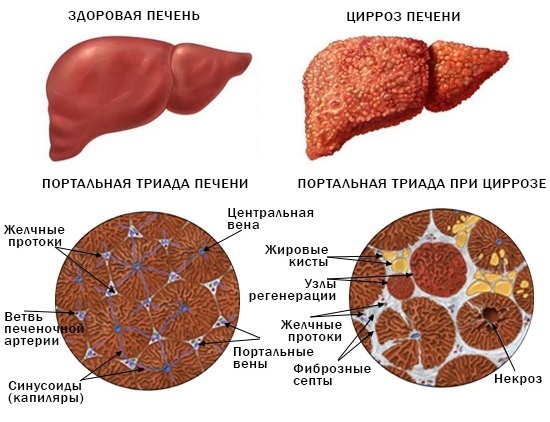
Cirrhosis of the liver
Cirrhosis of the liver (symptoms in women can be manifested by menstrual irregularities and uterine bleeding) characterized by specific signs, starting from the stage of subcompensation, when the pathological process switches to adjacent organs and systems.
Diagnostics
When the first alarm signals appear, you should immediately contact a therapist. The doctor initially conducts a visual examination of the patient for the presence of edema and signs of a decrease in the volume of circulating blood, and also examines the shade of the skin and visible mucous membranes.
Then he assesses the state of vital functions such as consciousness, breathing, blood circulation. In addition, the specialist measures blood pressure, pulse, then evaluates muscle tone and skin turgor.
If the fears are confirmed by visual examination, then the patient is referred to a hepatologist. To determine the exact diagnosis, laboratory tests are prescribed, as well as hardware research. The doctor, based on the data received, will be able to confirm or deny the fears.
Laboratory research
To establish a diagnosis, you should undergo certain laboratory tests that will reveal the degree of damage, stage and cause of development.
The main types of laboratory diagnostics:
- general blood test - a low level of erythrocytes, leukocytes, hemoglobin indicates a pathological process in the liver;
- coagulogram - the analysis helps to identify problems with blood clotting;
- serological markers - used to confirm viral hepatitis;
- stool analysis - shows possible gastric or intestinal bleeding;
- biochemical blood test - determines the concentration of creatinine, electrolytes, which indicates renal failure;
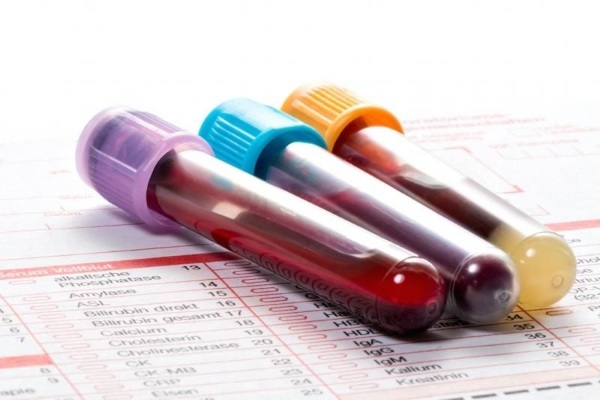
- urine test - shows the content of protein, erythrocytes.
Hardware diagnostics
Liver cirrhosis (symptoms in women and men do not always indicate liver dysfunction) can be established only after a complex examination of the patient, because it is impossible to determine the diagnosis purely by visual examination and even by the results of laboratory tests.
This is due to the fact that the same data can be for completely different diseases, because characteristic signs appear only with subcompensated cirrhosis.
The main types of hardware diagnostics:
- Ultrasound. The examination shows the exact size of the liver, the shape of the organ, and also helps to determine at what stage the pathological process is. In the resulting picture, you can see the presence of an inflammatory process and neoplasms in the organ. At the beginning of cirrhosis, the structure of the affected organ is homogeneous, and with further development, fibrous tissue is already visible, replacing healthy cells. With advanced cirrhosis, the right lobe of the liver is significantly reduced, and at the stage of decompensation, the total size of the organ is less than normal.
-
CT scan. This method of diagnosing the abdominal cavity shows in more detail the organ, its vessels and biliary tract. Based on this, it is possible to judge the homogeneity and density of the tissues. Also, tomography helps to determine the degree of patency of blood vessels and ducts. The pictures show birth defects, metastases, tumors. The data obtained help to confirm the diagnosis, identify the etiology and treatment tactics.

- Doppler sonography. The examination determines the blood flow rate, the presence of obstructions and the diameter of the vessels. Also, using dopplerometry, you can track changes in speed when holding your breath and straining.
- Biopsy. For analysis, a biomaterial is taken from the damaged organ. This helps to identify changes in the structure of a morphological nature and to suggest the root cause of their degeneration. In active cirrhosis, biopsy shows parenchymal necrosis, increased cell size, and no clear boundary between healthy and fibrous tissue. With an inactive form of the disease, there is no necrosis, and a separation between normal and affected cells is also visible.
Treatment of the disease
Cirrhosis of the liver is a chronic disease that cannot be completely cured. The therapy is carried out to eliminate the cause that provoked the disease, and also helps to reduce unpleasant symptoms in women and men. A special treatment regimen for cirrhosis has not yet been developed.
Medicines
Medicines are prescribed to maintain vital functions in the patient's body, as well as to prevent possible complications. The dosage regimen, dosage and course of therapy are prescribed by the attending physician based on the individual characteristics of the patient and the degree of degenerative changes in the organ.
The main groups of drugs that are used to treat liver cirrhosis:
- B vitamins. These components are needed to improve the structure of the organ. They participate in the synthesis of new cells and protect the remaining hepatocytes from destruction.
- Preparations based on animal raw materials. These medicines are made from components obtained from the liver of cattle and pigs. They have a detoxifying and antioxidant effect, as well as stimulate the regeneration of the parenchyma. The drug "Hepatosan" belongs to this category. Available in gelatin capsules. Reception is recommended for 15 minutes. before meals.
-
Herbal medicines. Such preparations based on natural ingredients are designed to support the function of the affected organ. They have anti-inflammatory, regenerative and antitoxic effects. Also, herbal preparations stop the destruction of hepotacytes. These include: Karsil, Hofitol, Liv 52, Galstena.

- Essential phospholipids. Preparations for the treatment of cirrhosis based on soybean extract. Contains components that promote cell regeneration. They also enhance detoxification, improve metabolic processes, reduce energy consumption of the damaged organ, and prevent the formation of fibrous tissue. This category includes: "Essentiale Forte", "Phosphogliv". The minimum course of admission is six months.
- Amino acids. These drugs promote the breakdown of fats, the synthesis of phospholipids, and also have a detoxifying and regenerating effect. These include: "Heprtral", Gela-mertz "," Heptor ". These drugs can be used in the form of tablets, as well as in droppers.
- Ursodeoxycholic acid. The drugs lower cholesterol levels in bile. They are used to treat biliary cirrhosis. These drugs include: "Ursosan", "Ursofalk", "Livodexa".
- Combined funds. These drugs have a complex effect, since they contain different components at the same time. This category includes: "Fosfonziale", "Esliver Forte", "Sirepar".
Folk remedies
Treatment with folk remedies can be used only at the initial stage of degenerative changes in the liver. They help to slow down the pathological process and improve the general condition of the patient.
Effective recipes:
- Corn. Boil the cob fibers in boiling water 1 to 2. Drink the resulting drink in the form of tea daily for 7 months.
- Garlic combined with lemon. This remedy helps to strengthen the immune system in the viral etiology of cirrhosis. To prepare the drug, you need to chop 2 heads of garlic, 2 lemons with a peel. Then add 100 ml of olive oil and 0.5 l of honey to the resulting mass. Mix all components until smooth. Reception should be carried out half an hour before meals, 1 tbsp. l.
- Carrot. Freshly squeezed juice from this vegetable contributes to the restoration of hepatocytes. It is recommended to prepare a drink immediately before taking. Drink twice a day for 2 months.
- Chicory root. A tincture based on this component helps to cope with the disease. To prepare it, you need to grind 50 g of the root and pour 250 ml of boiling water. Soak for 3 hours. Take 150 ml before meals for 2 months.
Surgical intervention
In the stage of decompensation, organ transplantation is the only method of treatment. At this stage, the liver does not perform its function, so any delay can be fatal. It is also possible to carry out an operation at an earlier stage of development, if all therapy has not brought positive dynamics and the disease continues to actively progress.
For transplantation, a donor is required who must meet the following requirements:
- age category over 18 years old;
- absolute coincidence in rhesus and blood group with the patient;
- absence of inflammatory processes in the liver;
- good health.

Transplantation lasts from 8 to 12 hours; a whole team of highly specialized doctors is involved in the operation.
After the operation, the patient spends 7 or more days in intensive care. During this time, the attending physician monitors the functioning of vital organs and systems, as well as the function of the transplanted liver. If after 3 days there are no signs of rejection, then the operation is considered successful.
The organ transplant patient needs to completely rethink his lifestyle. It is necessary to give up alcohol, adhere to dietary restrictions and constantly drink immunosuppressants so that the body does not perceive organ cells as foreign.
Diet therapy
Diet plays an important role in the treatment of liver cirrhosis. The diet is aimed at reducing the load on the affected organ.
Products that can and should not be consumed with cirrhosis:
| Allowed | Forbidden |
| Stale bread, flour products | Rye bread, pastry |
| Beef, poultry, rabbit, lean lamb and fish | Smoked meats, pickles, spicy and fried foods, spices, spices |
| Low-fat cottage cheese, sour milk | Salty and spicy cheeses |
| Rice, semolina, oatmeal, pasta | Lard, fatty fish and meat, goose, duck |
| Honey, marshmallow, sugar, jam | Ryazhenka, sour cream, cream |
| Eggs | Green onions, mustard, sorrel, peppers, radishes, spinach |
| Vegetables, not sour fruits, dill, parsley | Chocolate, cream cakes, ice cream |
A diet for cirrhosis of the liver is prescribed by a doctor, taking into account the patient's dietary habits, individual tolerance of products and other concomitant diseases. At the initial stage of the disease, it is recommended to include in the diet foods rich in complete proteins, containing essential amino acids.
With decompensated cirrhosis, when liver function is limited, it is necessary to reduce protein intake to 20-30 g per day. The patient should eat small meals 5-6 times a day.
Approximate diet:
- for breakfast - steamed meat soufflé, rice porridge with milk, baked apple;
- for lunch - vegetarian barley soup, noodles with cutlet, fruit jelly;
- for an afternoon snack - sweet crackers, rosehip broth;
- for dinner - steamed meatballs of lean meat, carrot puree, curd pudding, fruit jelly;
- at night - low-fat kefir.
Prognosis and complications
The prognosis at the stage of compensation and subcompensation of cirrhosis is quite favorable. But to maintain health, a person must follow a diet, eliminate bad habits and constantly take medications. With an advanced stage of liver cirrhosis, the lifespan in 40% of patients does not exceed 3-4 years.
A common cause of death is complications arising from cirrhosis:
- Hepatic encelopathy. The pathological process leads to neuropsychic disorders, which are manifested in behavior and consciousness. In this case, the blood accumulates toxins, which eventually damage the brain. The patient becomes inattentive, absent-minded, irritable. His speech is impaired, his behavior becomes inadequate.
-
Ascites. Fluid builds up in the patient's abdomen. This leads to squeezing of blood vessels and disruption of blood supply. At the same time, the navel turns outward. The patient is advised to rest in bed, restrict salt and take diuretics. If necessary, puncture of the abdominal cavity is performed.
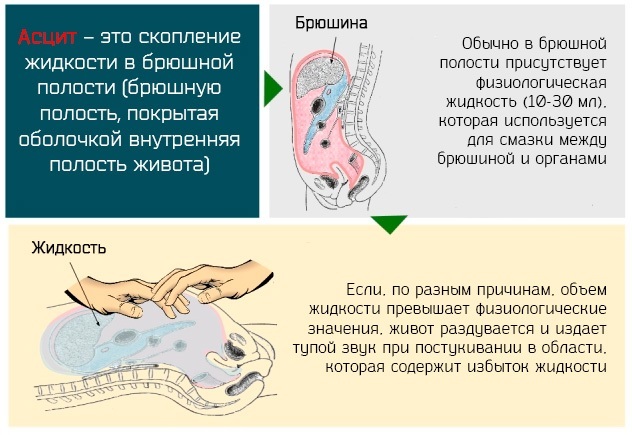
- Hepatic coma. The condition is characterized by a sharp decrease in the active cells of the organ. If at the same time changes in metabolic processes occur, then a hepatic coma develops. Its duration is 24-72 hours. Treatment is carried out in intensive care with constant monitoring of vital organs and systems. In this case, detoxification therapy with parenteral nutrition is carried out.
Cirrhosis of the liver is a dangerous disease that manifests itself in women and men. In the absence of timely treatment, it can be fatal. Therefore, if alarming symptoms appear, it is necessary to consult a doctor and undergo a comprehensive examination.
Article design: Vladimir the Great
Video about liver cirrhosis
Malysheva about liver cirrhosis:

